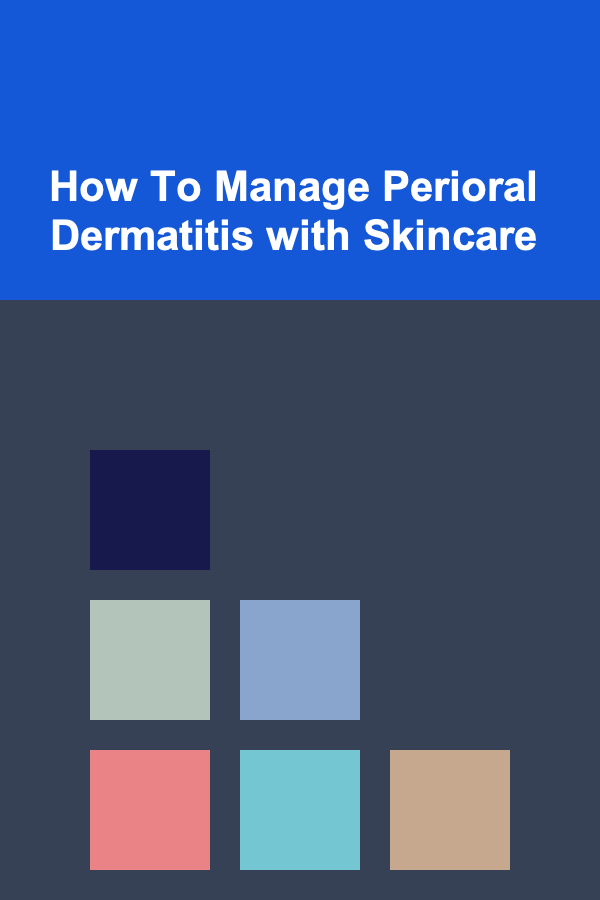
How To Manage Perioral Dermatitis with Skincare
ebook include PDF & Audio bundle (Micro Guide)
$12.99$8.99
Limited Time Offer! Order within the next:

Perioral dermatitis (POD) is a common yet often misunderstood skin condition that primarily affects the skin around the mouth and sometimes the eyes. It is characterized by red, inflamed, and often pustular lesions that resemble acne, though its causes and treatments differ significantly. This condition can cause significant distress, especially due to its recurring nature and impact on appearance. However, with proper skincare management, perioral dermatitis can be controlled and even prevented from recurring.
This article delves into how perioral dermatitis can be managed using skincare, offering a comprehensive guide on understanding, treating, and preventing outbreaks.
Understanding Perioral Dermatitis
Perioral dermatitis is an inflammatory skin condition that typically presents as red bumps, pimples, or pustules around the mouth. It often occurs in areas around the chin, nose, and sometimes the eyes. The condition tends to be more common in women, particularly those between the ages of 20 and 40, but it can affect anyone regardless of gender or age.
Symptoms of Perioral Dermatitis
The symptoms of POD can vary in severity but often include:
- Red or pink bumps on the skin
- Burning or stinging sensation
- Dry, flaky skin
- Pimples or pustules
- Swelling and irritation
- In some cases, it can affect the eyes, causing dryness, redness, or itching (a condition known as ocular perioral dermatitis)
Triggers and Causes of Perioral Dermatitis
While the exact cause of perioral dermatitis remains unknown, several factors can trigger or worsen the condition:
- Topical Steroids: One of the most significant triggers for POD is the use of topical steroids, particularly for long periods. These steroids can weaken the skin's barrier, making it more susceptible to inflammation and infection.
- Hormonal Changes: Fluctuations in hormones, especially during menstruation or pregnancy, can contribute to the development or exacerbation of perioral dermatitis.
- Stress: Psychological stress can have a significant impact on skin health, potentially triggering or worsening skin conditions like POD.
- Environmental Factors: Exposure to extreme temperatures, wind, or sunlight can irritate the skin and lead to outbreaks.
- Certain Foods: Spicy foods, alcohol, and hot beverages may trigger perioral dermatitis in some people.
- Bacterial or Fungal Infection: In some cases, bacteria or yeast that live naturally on the skin may play a role in the condition's development.
Skincare Routine to Manage Perioral Dermatitis
While managing perioral dermatitis requires more than just a skincare routine, incorporating the right steps into your daily regimen can significantly reduce flare-ups and prevent irritation. Skincare for POD must be gentle, soothing, and aimed at restoring the skin's natural barrier. Here's how to approach it:
1. Gentle Cleansing
Cleansing is the first and most crucial step in any skincare routine, but it becomes even more important when dealing with perioral dermatitis. Harsh cleansers can strip the skin of its natural oils and irritate inflamed skin.
- Use a Mild, Non-Foaming Cleanser: Opt for a soap-free, gentle cleanser that doesn't contain harsh ingredients like sulfates or alcohol. These ingredients can further dry out or irritate the skin. A cream or milk-based cleanser is ideal for sensitive skin.
- Avoid Scrubbing: Do not use abrasive scrubs or washcloths, as they can worsen inflammation. Gently massage the cleanser onto the skin using your fingertips, and rinse with lukewarm water.
- Cleansing Frequency: Cleanse your face twice daily---once in the morning and once before bed. Over-cleansing can strip the skin of its natural moisture, while under-cleansing can leave behind bacteria and dead skin cells that may exacerbate POD.
2. Moisturizing to Restore the Skin Barrier
Proper moisturizing is crucial when managing perioral dermatitis, as it helps restore the skin's natural barrier and reduce dryness and irritation. The key is to use non-comedogenic, fragrance-free moisturizers that won't clog the pores or trigger inflammation.
- Look for Soothing Ingredients: Moisturizers containing ingredients like ceramides, hyaluronic acid, and glycerin can help hydrate the skin and strengthen the skin barrier. These ingredients are gentle and non-irritating, making them ideal for sensitive skin.
- Avoid Heavy Creams: Opt for lightweight, non-oily moisturizers. Heavy creams or oils can clog pores and contribute to breakouts.
- Frequency of Moisturizing: Apply a thin layer of moisturizer twice daily, after cleansing, to keep the skin hydrated and protected.
3. Topical Treatments for Active Outbreaks
When an outbreak of perioral dermatitis occurs, topical treatments can help reduce inflammation and clear the lesions. However, it's important to avoid using harsh or over-the-counter acne treatments that could worsen the condition.
- Topical Antibiotics: Medications such as metronidazole and clindamycin are often prescribed by dermatologists to treat perioral dermatitis. These can reduce the bacterial overgrowth that may be contributing to the flare-up.
- Topical Azelaic Acid: Azelaic acid is a topical treatment that can help reduce the inflammation and redness associated with perioral dermatitis.
- Antifungal Creams: If a fungal component is suspected, antifungal creams like ketoconazole can be used as part of a treatment plan.
- Oral Antibiotics: In severe cases, oral antibiotics like tetracycline or doxycycline may be prescribed by a doctor. These medications target the underlying bacterial causes of perioral dermatitis and can help with more persistent outbreaks.
4. Sun Protection
Sun exposure can trigger perioral dermatitis flare-ups, making sunscreen a vital part of any skincare routine for those managing this condition. Sun exposure can also worsen the appearance of lesions and increase redness.
- Broad-Spectrum Sunscreen: Choose a broad-spectrum sunscreen with an SPF of at least 30. Opt for a mineral sunscreen that contains zinc oxide or titanium dioxide, as these are less likely to irritate sensitive skin.
- Fragrance-Free Sunscreens: Avoid sunscreens that contain fragrances or alcohol, as these ingredients can aggravate sensitive skin and exacerbate the condition.
- Reapply Regularly: Reapply sunscreen every two hours when outdoors, and more frequently if swimming or sweating.
5. Avoid Triggers and Irritants
Identifying and avoiding specific triggers is one of the most effective ways to manage perioral dermatitis. While the triggers may vary from person to person, there are common factors that are known to exacerbate the condition:
- Topical Steroids: If you are using topical steroids, it's crucial to follow your doctor's guidance carefully, as these can significantly worsen perioral dermatitis. Gradually tapering off steroids under medical supervision may be necessary to avoid a sudden flare-up.
- Spicy Foods and Alcohol: Spicy foods, alcohol, and hot beverages are known to trigger perioral dermatitis in some individuals. Consider eliminating these from your diet or reducing consumption.
- Stress Management: As stress can trigger flare-ups, incorporating stress-reducing techniques like mindfulness, meditation, yoga, or even simple breathing exercises into your daily routine may help manage the condition.
- Harsh Skin Products: Avoid using products that contain alcohol, astringents, or any ingredients that can strip the skin. Opt for soothing products that are formulated for sensitive skin.
6. Consistency is Key
Managing perioral dermatitis effectively requires consistency. Since this is a chronic condition, it's important to stick to your skincare routine and follow your dermatologist's advice. Even when the skin appears to be clear, continue maintaining a gentle skincare regimen to prevent future flare-ups.
Lifestyle Changes to Complement Skincare
While skincare plays a crucial role in managing perioral dermatitis, lifestyle changes can further support the healing process.
1. Diet and Hydration
- Stay Hydrated: Drink plenty of water throughout the day to keep your skin hydrated and help flush out toxins.
- Eat an Anti-Inflammatory Diet: A diet rich in fruits, vegetables, and omega-3 fatty acids can reduce inflammation and support skin health. Avoiding processed foods, sugar, and dairy may also help prevent flare-ups for some individuals.
2. Stress Management
Chronic stress can negatively affect your skin's health. Engaging in regular physical activity, practicing relaxation techniques, or finding a hobby you enjoy can help reduce stress levels and, by extension, the severity of perioral dermatitis outbreaks.
3. Avoid Touching Your Face
Frequent touching of the face can transfer bacteria and irritants to the skin, worsening inflammation. Make an effort to avoid touching your face or resting your chin on your hands to reduce the risk of flare-ups.
Conclusion
Managing perioral dermatitis with skincare is about choosing gentle, effective products that restore balance to the skin while avoiding triggers that may exacerbate the condition. A tailored skincare routine---comprising gentle cleansing, proper moisturizing, sun protection, and targeted treatments---combined with a healthy lifestyle, can significantly improve the condition and reduce the frequency of flare-ups. Though perioral dermatitis can be persistent, with careful management and consistency, it's possible to control and even prevent the recurrence of symptoms, leading to healthier, clearer skin.

How to Choose the Best Tools for Virtual Collaboration
Read More
How to Prevent Common Plumbing Issues Before They Happen
Read More
Mastering Warehouse Management: Advanced Strategies for Boosting Productivity and Reducing Costs
Read More
How To Identify Foreshadowing Through Visual Cues
Read More
How to Edit Photos Like a Pro in Lightroom
Read More
How to Plan for Graduate School Applications with an Academic Planner
Read MoreOther Products

How to Choose the Best Tools for Virtual Collaboration
Read More
How to Prevent Common Plumbing Issues Before They Happen
Read More
Mastering Warehouse Management: Advanced Strategies for Boosting Productivity and Reducing Costs
Read More
How To Identify Foreshadowing Through Visual Cues
Read More
How to Edit Photos Like a Pro in Lightroom
Read More